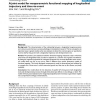Free Online Productivity Tools
i2Speak
i2Symbol
i2OCR
iTex2Img
iWeb2Print
iWeb2Shot
i2Type
iPdf2Split
iPdf2Merge
i2Bopomofo
i2Arabic
i2Style
i2Image
i2PDF
iLatex2Rtf
Sci2ools
BMCBI
2006
2006
A joint model for nonparametric functional mapping of longitudinal trajectory and time-to-event
Background: The characterization of the relationship between a longitudinal response process and a time-to-event has been a pressing challenge in biostatistical research. This has emerged as an important issue in genetic studies when one attempts to detect the common genes or quantitative trait loci (QTL) that govern both a longitudinal trajectory and developmental event. Results: We present a joint statistical model for functional mapping of dynamic traits in which the event times and longitudinal traits are taken to depend on a common set of genetic mechanisms. By fitting the Legendre polynomial of orthogonal properties for the time-dependent mean vector, our model does not rely on any curve, which is different from earlier parametric models of functional mapping. This newly developed nonparametric model is demonstrated and validated by an example for a forest tree in which stemwood growth and the time to first flower are jointly modelled. Conclusion: Our model allows for the detect...
| Added | 10 Dec 2010 |
| Updated | 10 Dec 2010 |
| Type | Journal |
| Year | 2006 |
| Where | BMCBI |
| Authors | Min Lin, Rongling Wu |
Comments (0)

